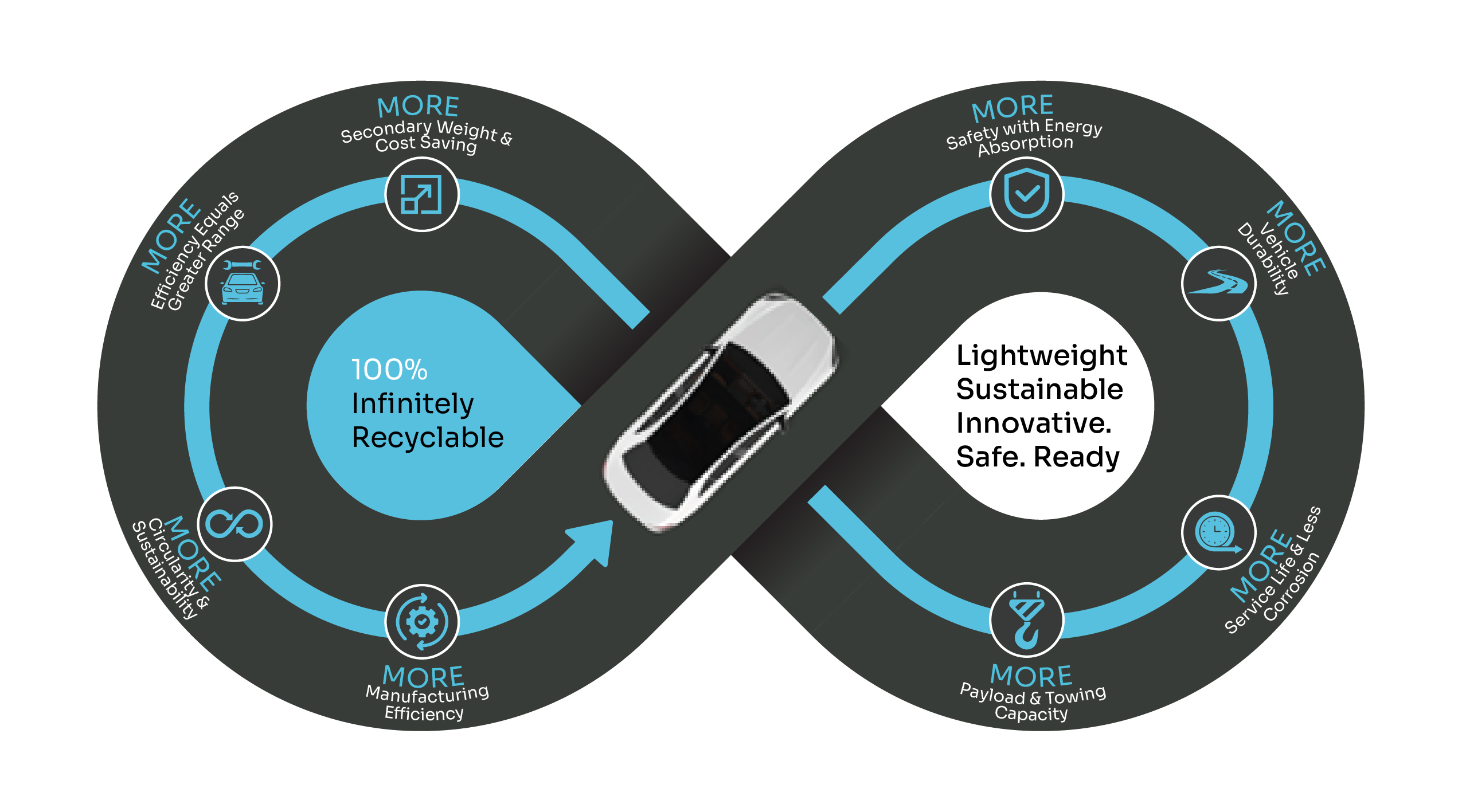Less is More – 8 Ways Aluminium Drives Mobility Value

September 3, 2024
In a recent feature, Aluminium International Today spotlights Alumobility’s whitepaper findings on how aluminum delivers less weight and more value for manufacturers and vehicle owners.
Aluminum, which is 67% less dense than steel, is rapidly becoming the material of choice for automakers looking to create smarter, lighter, safer and more sustainable vehicles. When comparing two identical vehicles with equal stiffness and load-carrying capacity– one made of aluminum, the other of steel–the aluminum vehicle body will be up to 45% lighter, which provides significant advantages that will affect the future of the automotive industry, especially as it shifts to electrification.
Alumobility recently launched a white paper: When it Comes to Aluminum, Less is More, which highlights 8 major reasons why aluminum is the material of the future for automakers. This graph and summary topline the benefits detailed in the white paper.
- LESS WEIGHT = MORE EFFICIENCY AND RANGE: Aluminum lightweighting benefits both internal combustion engine vehicles and battery electric vehicles (BEVs) by improving mileage, fuel consumption, and emission reduction in ICE vehicles, while enhancing the range capability and offsetting the heavy batteries required for electrification in BEVs.
- LESS WEIGHT = MORE SECONDARY SAVINGS: Lighter aluminum bodies enable the use of smaller parts, resulting in secondary savings in components such as brakes, suspension parts, batteries, and motors. This translates into greater acceleration, performance, and range with fewer emissions. Additionally, smaller batteries in BEVs lead to reduced extraction of raw materials and chemicals during manufacturing, contributing to environmental and resource protection.
- LESS WEIGHT = MORE SAFETY: Contrary to common belief, lighter aluminum vehicles can be safer than steel-based vehicles due to aluminum’s ability to absorb more energy in a crash. This not only enhances occupant safety but also benefits other road users by reducing the mass involved in accidents.
- LESS WEIGHT = MORE VEHICLE DURABILITY: Aluminum vehicles experience less friction on key components, leading to reduced wear and tear on tires and brakes. This results in fewer particle emissions and a longer vehicle lifespan.
- LESS CORROSION = MORE YEARS IN SERVICE: Automotive-grade aluminum alloys are less prone to corrosion compared to steel, thanks to their self-healing protective barrier. This enhances the longevity of aluminum vehicles, reducing maintenance costs and increasing their years in service.
- LESS WEIGHT = MORE PAYLOAD AND TOWING CAPACITY: Aluminum-intensive vehicles such as pickup trucks, SUVs, and delivery vehicles can carry more cargo and have greater towing capacity compared to their steel counterparts. This reduces the impact on roads and infrastructure while potentially lowering maintenance costs.
- LESS COMPLEXITY = MORE EFFICIENCY IN MANUFACTURING: Manufacturing aluminum-intensive vehicles requires fewer parts, tools, robots, energy, and factory emissions compared to steel-intensive vehicles. This simplifies the production process, reduces complexity, and results in lower inventory and capital requirements. Additionally, aluminum is highly recyclable, with over 90% of the material recoverable for reuse, contributing to a more sustainable end-of-life recycling process.
- LESS WASTE = MORE CIRCULARITY: Aluminum is infinitely recyclable without any loss in its properties, making it more sustainable than steel. Closed-loop recycling processes reduce carbon emissions immediately, while end-of-life recycling presents opportunities for further reductions. Compared to steel, aluminum recycling requires lower temperatures, resulting in energy savings during the recycling process.
In conclusion, there are numerous benefits for accelerating aluminum use in motor vehicles. As explained, infinitely recyclable, lightweight aluminum provides important advantages demonstrating its superiority as the material of the future for mobility.
This story was previously published on Aluminium International today. To see the original publication, click here.